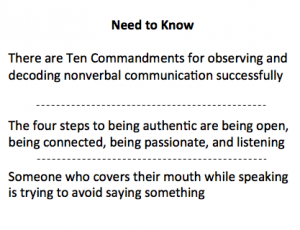A Field Guide to Nonverbal Communications
Nonverbal: Part Three
Sept. 21, 2015 ~ Written by: W.B. “Bud” Kirchner
 “The single biggest problem in communication is the illusion that it has taken place.” George Bernard Shaw
“The single biggest problem in communication is the illusion that it has taken place.” George Bernard Shaw
In an earlier post from a series on “Thinking Errors,” I introduced the concept of a ‘field guide’ analogy regarding certain principles, facts, etc. My idea is to provide enough detail in an easy to follow manner that you will recognize key items in your everyday business life. Occasionally, you will still need to do a bit of work to further classify and better personalize material. Once again, I will use this approach here.
A Quick Caveat (or three)
This is not intended to be a definitive (nor dare I say academic or scientific) description. In the words of someone who tries to use this stuff every day in the real world – of business – I am sharing what seems to be the Goldilocks bowl.
This is not foolproof but if nothing else they will heighten your sensitivity to nonverbal signals. I encourage you to review the previous post – at least the section on qualifiers that could contradict or reinforce what you think you are hearing/seeing.
What follows now are some simple illustrations of nonverbal ‘communication.’ Note: I am keeping the big one (smile) until the next post.
I have become intrigued by a couple broader stroke concepts regarding nonverbal communication which is where I will begin. While they are each applicable to both inbound and outbound messaging I present them here mostly in the context of delivering a convincing (nonverbal) message.
The Ten Commandments
No – not those Ten Commandments. I’m referring to some general guidelines from “What Every BODY is Saying,” by Joe Navarro. Guidelines he calls “The Ten Commandments for Observing and Decoding Nonverbal Communications Successfully.”
I have taken the liberty of underlining what I believe is the key word.
- Be a competent observer of your environment.
- Observing in context is key to understanding nonverbal behavior.
- Learn to recognize and decode nonverbal behaviors that are universal.
- Learn to recognize and decode idiosyncratic nonverbal/enhanced behaviors.
- When you interact with others, try to establish their baseline
- Always try to watch people for multiple
- Look for changes in person’s behavior that signal changes in thought, emotion, interest.
- Learning to detect false or misleading nonverbal signals is critical
- Know how to distinguish between comfort and discomfort.
- When observing others be subtle.
The Six Planes
No – not those planes. I’m talking about the work of Mark Bowden. His book “Winning Body Language” covers several aspects of nonverbal communication. Bowden has a background in theatre and other related areas so he is focused on (but not limited to) gestures – as he described in “the GesturePlane system.”
At this point I think the gestures idea is well worth our time. As he explains it:
“The key tenet of the GesturePlane system is that the feeling evoked by a verbal message can be radically and predictably changed in the performer and the perceiver by simply (amongst other things) the horizontal height at which the performer holds their hands.”
With this in mind he divides the body, starting at the head and descending to the feet, into six planes. Keep in mind – this refers to where the hands are during interactions and the message being sent.
- Ecstasy Plane
- Above the head (rare for a business meeting).
- Thought Plane
- Slightly above and below the eyes.
- Disclosure Plane
- Slightly above and below the mouth.
- Passion Plane
- As you might imagine, from shoulders to hips centered on the heart (and the widest zone).
- Truth Plane
- Around your belly button (think center of gravity as core and seat of consciousness in Eastern philosophy).
- Grotesque Plane
- Truth plane to the ground (like ecstasy plane, rare for a business meeting).
The Four Steps
Finally, some ideas from “Trust Me: Four Steps to Authenticity and Charisma,” by Nick Morgan. The basic principle is: at the subconscious level, gestures register first and our limbic brain tells us if that person is authentic and believable
Morgan developed a four step approach based on that belief so it makes sense to create the intention of your communication first – then the gesture will appear naturally. That will be followed by your thoughts and finally your actual words. Your focus objective is to get verbal and nonverbal in sync.
- Step One: Being Open
- Step Two: Being Connected
- Step Three: Being Passionate
- Step Four: Listening
The three examples above (Commandments, Planes and Steps) illustrate categories of information (under the umbrella of our Business Brain Model℠) that needs to be leveraged to be effective in nonverbal communication.
The List
Below is a series of nonverbal signals that are not intended to reveal some incredible ‘tell’ that will enable you to pick up on a simple signal and make a monumental interpretation on another’s thoughts. Rather, I hope that you become more aware of the signals you are sending and are sensitive to the signals others are sending you.
These are some cues I have seen in negotiations and deal making. Subsequent events confirmed my interpretation. Validation may be too strong a word, but nevertheless, these are the ones I’ve come to rely on during my extensive career with Kirchner Group.
| Visuals | Likely Interpretation | Comments |
| Angling up of inner eyebrows | Sadness |
|
| Rubbing nose | Lying | Adrenaline rush into the nose |
| Pupil dilated | Conscious thinking involved | Attraction/interest |
| Pupil contracted | Negative emotions | Aggression/anger |
| Eye Dart |
|
Often seen in business settings |
| Lean back/move away |
|
|
| Covering mouth while speaking | Trying to avoid saying something | Subconscious trying to check conscious |
| Head down | Disapproval or dejection | Submission |
| Elbows up and pointed | Desire to dominate | Evolutionary for posturing |
| Leg over arm of chair | Indifference | Disengaged with goings on |
| Edge of chair – leaning forward | Desire for personal interaction | Physically engaged |
| Standing with hands on hips | Aggression | Poised for action |
| Locked ankles | Apprehension | Holding back info and/or commitment |
| Sitting with hands clasped behind head, legs crossed | Confidence, superiority | Overlording |
| Looking down, face turned away | Disbelief | Inability to make eye contact |
| Tugging at ear | Indecision | Displacement activity |
| Staring eyes | Intensity | Elicits flight or fight |
One final note, a good source of photos on nonverbal messages (and an illustration of how limited my list is) see the aforementioned book by Joe Navarro.
In closing (and by way of reinforcement), I am not suggesting you don’t do business with someone who rubs their nose – I am only suggesting you spend a bit more time validating their honesty.
About the Author: W.B. “Bud” Kirchner is a serial entrepreneur and philanthropist with more than 50 years of business success. He is not a scientist or an academic but he does have a diversified exposure to neuroscience, psychology and related cognitive sciences. Generally speaking, the ideas he expresses here are business-angled expansions of other people’s ideas, so when possible, he will link to the original reference.
